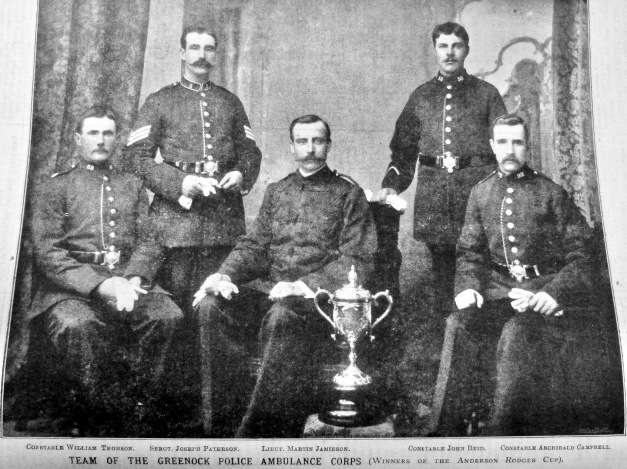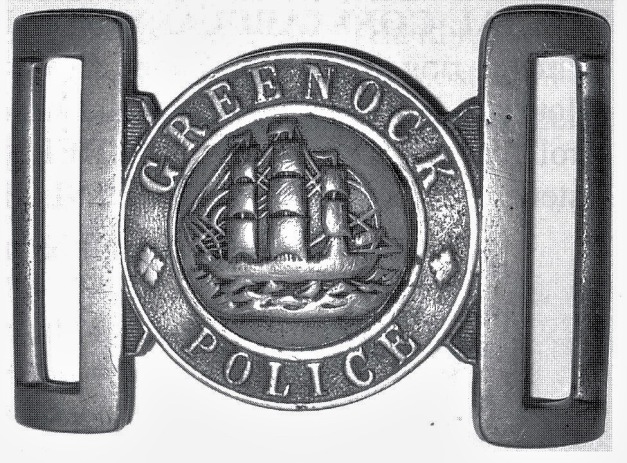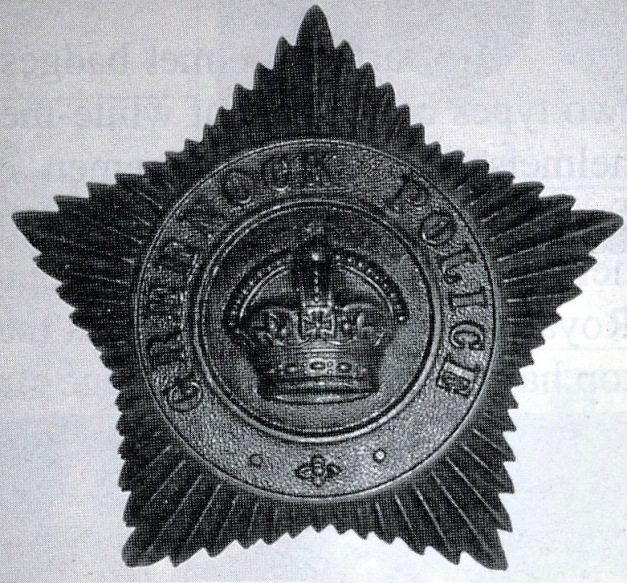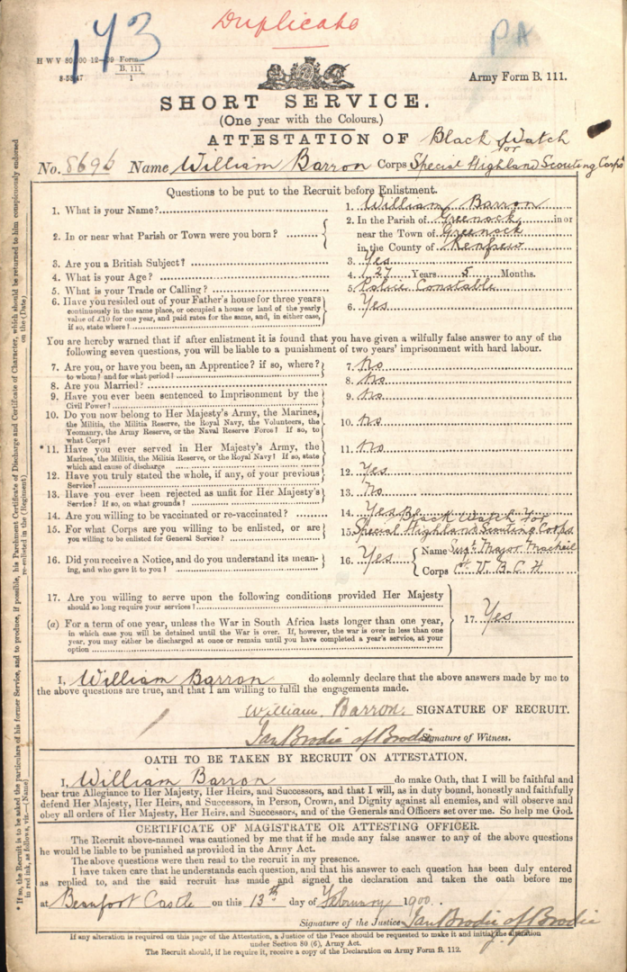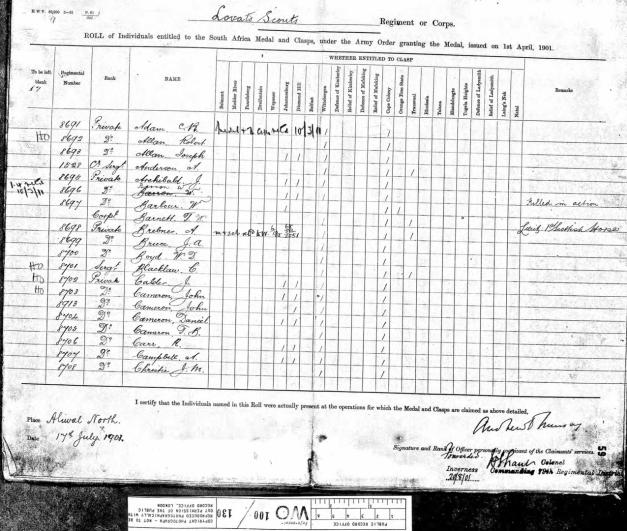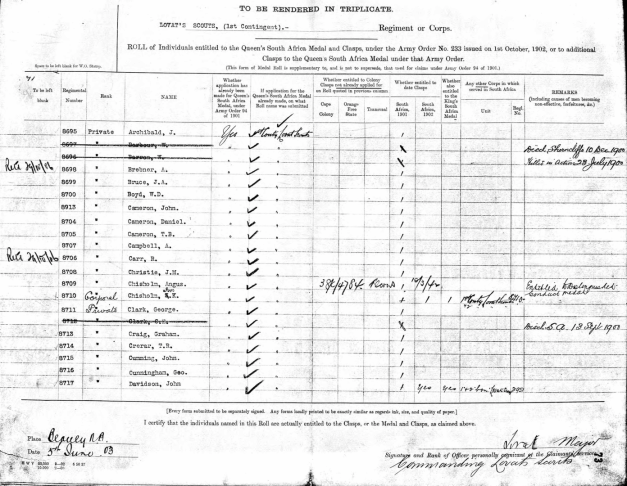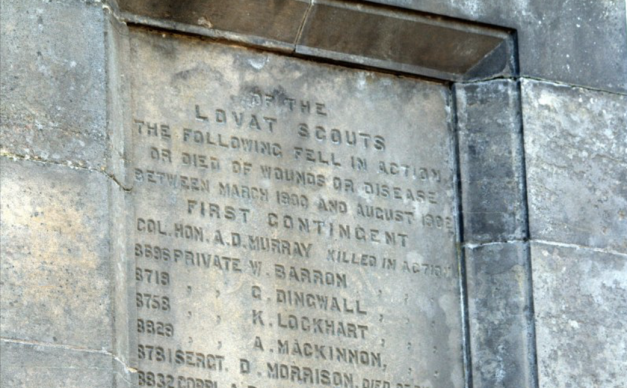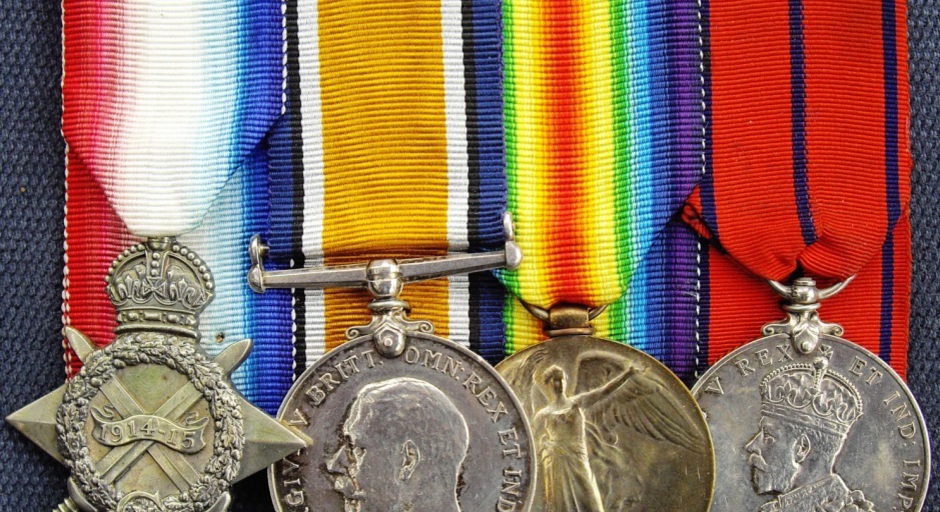
Greenock Burgh Police and The Boer War 1899 - 1902
Greenock Burgh Police
PC Alexander Buchan
Queen’s South Africa Medal, 1901, Clasps, ‘Wittebergen’, ‘Cape Colony’ and ‘Transvaal’
Introduction
Alexander Buchan was born in 1875 near Coupar-Angus in Perthshire . His father was Alexander Buchan, a Shepherd and his mother, Margaret Douglas or Buchan. His parents were married in Dundee in the County of Angus on 8 December 1865. His father moved for work and the Census’ and birth records show the family moving around farms in Perthshire and Angus, eventually settling near Auchterarder. His mother died in 1877 aged 42 and his elder sister, Charlotte, took over the housekeeping duties for the young family.
Alexander (junior) worked as a Farm Labourer and sometime after his 18th birthday (1893), he joined Greenock Burgh Police and eventually became part of its Mounted Police section. It was from the Mounted section in January 1901, that he volunteered for active service in South Africa during the 2nd Boer War, with the Ayrshire Company of the Imperial Yeomanry.
Some contemporaries of PC Buchan can be seen in the picture above taken in 1898.
What follows is a chronological history of Alexander Buchan’s life extracted from newspapers and public records. I have recorded the details as they are transcribed in Ancestry records. There are some obvious mis-transcriptions regarding places and ages.
The Early Years
In the Census of 1871, the following were living Blairgowrie in Perthshire:
|
Name & Age |
Occupation |
Place & County of Birth |
|
Alexander Buchan, (33) |
Ploughman |
Rattray, Perthshire |
|
Margaret Buchan, (33) |
Wife |
Logie Rait, Perthshire |
|
Charlotte Buchan, (5) |
Daughter |
Moulin, Perthshire |
|
James Buchan, (4) |
Son |
Blairgowrie, Perthshire |
|
Charles Buchan, (2) |
Son |
Longforgan, Perthshire |
This is Alexander’s parents and elder sister and brothers living in Blairgowrie before he was born.
Register of Births in the Parish of Coupar-Angus in the County of Perth, 1875
Alexander Buchan was born on 7 January 1875 at Balbeggie, Coupar-Angus, Perthshire. His father was Alexander Buchan, Shepherd and his mother, Margaret Douglas or Buchan. They had been married at Dundee on 8 December 1865.
Register of Deaths in the Parish of Longforgan in the County of Perth, 1877
Margaret Buchan, (42), married to Alexander Buchan, Shepherd, died of Typhoid Fever on 1 October 1877 at Dron in the Parish of Longforgan. Her husband registered her death.
Census of Scotland , 1881
Living at Dron Farm Cottages in the Parish of Longforgan, Perthshire on the night of the Census of Scotland 1881 were the following:
|
Name & Age |
Occupation |
Place & County of Birth |
|
Alexander Buchan, (42) |
Shepherd |
Rattray, Perthshire |
|
James Buchan, (14) |
Son, Apprentice Wood Turner |
Blairgowrie, Perthshire |
|
Charles Buchan, (12) |
Son, Scholar |
Lintrathen, Angus |
|
Alexander Buchan, (6) |
Son, Scholar |
Coupar-Angus, Perthshire |
|
George B. Buchan, (3) |
Son |
Longforgan, Perthshire |
|
Charlotte Douglas Buchan, (15) |
Daughter, House Duties, Domestic |
Moulin, Perthshire |
|
Margaret Allison Buchan, (8) |
Daughter, Scholar |
Rattray, Perthshire |
Charlotte Buchan has now taken over the housekeeping duties from her late mother.
Census of Scotland , 1891
Living at Kirkgate Cottage in the Parish of Ruthven, Angus on the night of the Census of Scotland 1891 were the following:
|
Name & Age |
Occupation |
Place & County of Birth |
|
Alexander Buchan, (52) |
Shepherd |
Rattray, Perthshire |
|
Charlotte Douglas Buchan, (25) |
Daughter, House Duties, Domestic |
Moulin, Perthshire |
|
George B. Buchan, (13) |
Son, Scholar |
Longforgan, Perthshire |
|
Martha R. P. Buchanan, (7) |
Grand daughter |
Dundee, Forfar |
|
Angus D. Buchan, (4) |
Grandson |
Brechin, Forfar |
|
William Buchan, (2) |
Grandson |
Ruthven, Angus |
Charlotte is still carrying out domestic duties for her father.
Census of Scotland , 1891
Living at Ferns of Clayquhat in the Parish of Kirkmichael, Perthshire on the night of the Census 1891 were the following:
|
Name & Age |
Occupation |
Place & County of Birth |
|
George Dick, (59) |
Farmer |
Blairgowrie, Perthshire |
|
Catherine Dick, (640 |
Farmer’s Wife |
Rattray, Perthshire |
|
Archibald Dick, (32) |
Farmer’s Son |
Blairgowrie, Perthshire |
|
Alexander Buchan, (16) |
Farm servant |
Coupar-Angus, Perthshire |
This was Alexander Buchan’s employment before he joined Greenock Burgh Police after 1893.
17th Company, 6th Battalion Imperial Yeomanry
PC Alexander Buchan of Greenock Burgh Police enlisted in the 17th (Ayrshire) Company of the 6th Battalion Imperial Yeomanry in January 1900.
The Greenock Telegraph & Clyde Shipping Gazette, 6 January 1900
Under the headline, “Greenock Constables for the Imperial Yeomanry’, the Greenock Telegraph & Clyde Shipping Gazette of 6 January 1900 reported the following:
“The two members of the Greenock Police Force, Constables Alexander Buchan and Andrew S. Webster, who have volunteered to serve at the front with the Imperial Yeomanry, journeyed to Ayr yesterday to undergo the riding and shooting tests.
Nearly the whole of the men who have been selected in connection with the Ayrshire Yeomanry were present, and the weather being favourable, the examinations were got through expeditiously.
Owing to Constable Buchan’s connection with the mounted police, he was not called upon to go through the riding test, but Constable Webster had to mount, and was put through his paces on the racecourse and along the water side.
The men afterwards proceeded to the shooting range, where the firing took place. Several of the civilians failed to satisfy the examiners; but both the Greenock representatives got through easily. Before returning to town, Buchan and Webster were told to hold themselves in readiness for immediate departure. The exact date has not yet been fired. Both men intend to select a horse of their own before mobilising.”
The Greenock Telegraph & Clyde Shipping Gazette, 15 January 1900
Under the headline, “Greenock and the War’, the Greenock Telegraph & Clyde Shipping Gazette of 15 January 1900 reported the following:
“Constables Alexander Buchan and Andrew S. Webster of Greenock Police Force, who recently volunteered for active service in the Imperial Yeomanry, received an official communication yesterday requesting them to proceed to Ayr on Wednesday along with their horses. The mobilisation is to take place then, and it is expected that the men will leave shortly for the seat of the war.”
Greenock Telegraph & Clyde Shipping Gazette, 17 January 1900
Under the headline, “Departure of Mounted Policemen Today, the Greenock Telegraph & Clyde Shipping Gazette of 17 January 1900 reported the following:
“Constables Alexander Buchan and Andrew S. Webster, of the Greenock Police Force, who have been selected for active service with the Imperial Yeomanry, under orders for South Africa, left Greenock this morning for the headquarters of the Ayrshire Yeomanry Cavalry, preparatory to proceeding for the seat of war.
The two men received an enthusiastic send-off from their comrades in the force, a number of mounted friends, and many townspeople.
According to previous arrangements, the constables to the number of eighty, along with forty mounted townsmen, paraded in the vicinity of the Central Police Station, Dalrymple Street, shortly after eight o’ clock this morning, and notwithstanding the early hour, and the somewhat disagreeable weather, the muster was witnessed by a large number of spectators.
Headed by Captain Angus on horseback, the parade marched off to the stirring strains of the bagpipes. Following Pipe-Major Balloch of the K. O. S. B. were the constables on foot, immediately behind were the mounted friends and the two men for the front.
Several of those in the parade carried flags and Union Jacks and the turnout, as it proceeded along Hamilton, West Blackhall, and Brougham Streets to Princes Pier, attracted great attention and evoked considerable enthusiasm. The mounted men as they rode two abreast, presented a fine appearance, their turnout being not unlike a troop of regular cavalry.
On arrival at the station grounds the constables formed up at open-order on both sides of the road, and Troopers Buchan and Webster passed through the opened ranks amid great cheering. Before passing into the station, which was gaily decorated with flags and bunting , Captain Angus cordially shook hands with the two men.
The interior of the station was filled with spectators and the train – the engine of which was decorated with Union Jacks – steamed off at 9.20 amid great cheering and a perfect fusillade of fog signals.
Last night a social gathering of the local troopers who have been selected for active service in South Africa, together with their friends, was held in the Tontine Hotel. There was a large company, which was presided over by Captain Angus. During the evening a long toast-list was gone through. Suitable reference was made to the patriotism displayed by so many Greenockians in offering their services for the front.”
Greenock Telegraph & Clyde Shipping Gazette, 25 January 1900
Under the headline, “Greenock and the War, the Greenock Telegraph & Clyde Shipping Gazette of 25 January 1900 reported the following:
“PRESENTATION TO TROOPPERS BUCHAN AND WEBSTER – Yesterday evening, Troopers Alexander Buchan and A. S. Webster were entertained to a cake and wine banquet in the saloon of the Town Hall, prior to leaving for South Africa along with a section of the Imperial Yeomanry.
There were present a large contingent of their comrades in the Police Force, and a representative gathering of the business men of the town.
Provost Black presided and was supported by several of his colleagues, and Captain Angus, Superintendent Jamieson, Lieutenant Adams and Inspector Christie.
An appropriate toast-list was gone through. At an interval, Provost Black presented each of the Troopers with a well-filled purse of sovereigns and binocular glasses, as a token of respect in which they were held by a large circle of friends in Greenock (Applause).
The Provost commended the men for their pluck in offering to assist in the difficult task their country had on hand. He hoped they would do their duty and if they returned home again, he was sure the inhabitants of Greenock would ready to welcome them (Applause).
Trooper Buchan, on behalf of himself and his comrade returned thanks. He had also to thank Captain Angus for the encouragement he had given them in relieving them so soon after they had volunteered. Several songs were sung during the evening and the company broke up with ‘Auld Lang Syne’.”
Greenock Telegraph & Clyde Shipping Gazette, 12 April 1901
Under the headline, “Death of another Greenock Constable at the Front, the Greenock Telegraph & Clyde Shipping Gazette of 12 April 1901 reported the following:
“Today’s War Office List of Casualties in South Africa includes the death of 1448 Private Alexander Buchan, of the 17th Company (Ayrshire) Imperial Yeomanry, which took place at Ladybrand on Tuesday.
As was stated in the ‘Telegraph’ on Tuesday, Private Buchan was seized with enteric fever at the beginning of the week, to which disease he has succumbed.
Private Buchan was a member of the Greenock Mounted Police force and was the first to volunteer for active service when men were called for.
Along with A. Webster, another member of Greenock Police Force, he left for South Africa in January of last year and since then has seen much service.
Only last Saturday, his chief, Captain Angus, received an interesting letter from him (the last he is believed to have written), giving an account of the operations against De Wet.
The deceased Trooper who during the campaign had earned the reputation of being one of the most dashing riders in the Scottish Yeomanry, was twenty-six years of age.
He was a native of Coupar-Angus, and his father at present, resides at Cornhill, near Auchterarder. Private Buchan was on strength of Greenock Police up till his death, he being on leave of absence in South Africa; and Captain Angus had a vacant Inspectorship for him on his return.
This is the second death among Greenock Constables serving at the front, the other being Private Barron, of Lord Lovat’s Scouts, who died of months several months ago.”
Medal Roll of 17th Company, 6th Battalion Imperial Yeomanry, 1901
The medal Roll of the unit dated 9 August 1901 at Bloemfontein shows Alexander Buchan's entitlement to the award of the Queen’s South Africa Medal and clasps listed above. The entry against Private 1448 Buchan, A, shows that he died on 9 April 1901 of disease at Ladybrand.
The End of the Story
In the Census of 1901, living at Cornhill, near Auchterarder, Perthshire, were the following:
|
Name & Age |
Occupation |
Place & County of Birth |
|
Alexander Buchan, (64) |
Shepherd |
Rattray, Perthshire |
|
Charlotte Douglas Buchan, (35) |
Daughter, Housekeeper |
Moulin, Perthshire |
|
Angus D. Buchan, 10) |
Grandson |
Brechin, Forfar |
|
William Buchan, (12) |
Grandson |
Ruthven, Perthshire |
|
Stewart Buchan, (7) |
Grandson |
Meigle, Perthshire |
|
James Buchan, (5) |
Grandson |
Meigle, Perthshire |
Charlotte is still carrying out domestic duties for her father.
Register of Deaths in the Parish of Auchterarder in the County of Perth, 1912 & 1922
Alexander Buchan, (74), Shepherd, Widower of Margaret Douglas, died on 26 March, 1912 at 19 Townhead, Auchterarder. His son-in-law, Duncan Robertson, registered his death.
Charlotte Buchan or Robertson, (57) died in Auchterarder in 1922.
Greenock Burgh Police
PC William Barron
Queen’s South Africa Medal, 1901, Clasps, ‘Johannesburg’, ‘Diamond Hill’, ‘Wittebergen’, ‘Cape Colony’ and ‘South Africa-1901’
Introduction
William Barron was born on 21 June 1872 at Aberdour in Aberdeenshire. His father was William Barron, a Farm Servant and his mother, Christian Gibson Thom or Barron.
He lived and worked as a Farm Servant in Banffshire before he joined Greenock Burgh Police after the Census of Scotland, 1891, probably, 1895 (see newspaper article 2 January 1901 below).
He was 26 and unmarried when in 1900, he volunteered for active service in South Africa with the Lovat Scouts and after several months of fighting the guerrilla war, he was killed in action at Naauwpoort Nek.
What follows is extracted from local newspapers and public documents. They have been transcribed as they are written, and it will be apparent that some errors have crept in over the years. I have left the original data in the interests of accuracy.
The Early Years
In the Census of Scotland, 1881, the following were living at Pitgair Labourer’s Cottage, Gamrie in the County of Banff.
|
Name and Age |
Occupation |
Place & County of Birth |
|
Robert Barron, (31) |
Farm servant |
Aberdour, Aberdeenshire |
|
Christian Barron, (32) |
Wife |
Pitsligo, Aberdeenshire |
|
Helen Barron, (12) |
Daughter, Scholar |
Aberdour, Aberdeenshire |
|
Robert Barron, (10) |
Son, Scholar |
Aberdour, Aberdeenshire |
|
William Barron, (8) |
Son, Scholar |
Aberdour, Aberdeenshire |
|
Mary Ross Barron, (5) |
Daughter |
Aberdour, Aberdeenshire |
|
Matilda Lily Barron, (3) |
Daughter |
Aberdour, Aberdeenshire |
|
Ann Barron, (1) |
Daughter |
Aberdour, Aberdeenshire |
The Census of Scotland 1891
In the Census of Scotland, 1891, the following were living at Ardlaw Mains Farm, Pitsligo, Aberdeenshire.
|
Name and Age |
Occupation |
Place & County of Birth |
|
Robert Barron, (42) |
Farm servant |
Aberdour, Aberdeenshire |
|
Christian Barron, (43) |
Wife |
Pitsligo, Aberdeenshire |
|
Ann Barron, (11) |
Daughter |
Gamrie, Aberdeenshire |
|
Maria Barron, (8) |
Daughter, Scholar |
Gamrie, Aberdeenshire |
|
Christina E. Barron, (6) |
Daughter, Scholar |
Gamrie, Aberdeenshire |
|
Maggie D. Barron, (2) |
Daughter |
Gamrie, Aberdeenshire |
The Census of Scotland 1891
Among the 13 people living with Francis William Runcie, Farmer, at Bruntbrae, Alvah in the County of Banff on the night of the Census of Scotland, 1891 was:
|
Name and Age |
Occupation |
Place & County of Birth |
|
William Barron, (17) |
Farm servant |
Aberdour, Aberdeenshire |
The Lovat Scouts
Robert Barron volunteered for active service on 13 February 1900 at Beaufort Castle, near Beauly, Inverness-shire. He was allocated the Army Number 8696 and volunteered for the ‘Black Watch Special Scouting Corps’ (original name of Lovat Scouts). Curiously, although his occupation is given as ‘Police Constable’ and all other details are correct, his place of birth is given as Greenock.
His description was 5’ 11”, 12 stone 8 pounds, 27 years and 5 months old, with a medium complexion, grey eyes and brown hair. Under ‘distinguishing marks’, he was said to have ‘three patches of black hair on his left side above and behind his ear’. He was passed fit in the medical examination on the same date.
His next of kin was ‘Robert Barron, Ardlaw Mains, Fraserburgh’, his father.
Robert served at ‘Home’ between 13 February 1900 and 10 March 1900.
Greenock Telegraph & Clyde Shipping Gazette, 26 February 1900
Under the heading, ‘PRESENTATION TO A GREENOCK CONSTABLE’, the Greenock Telegraph & Clyde Shipping Gazette edition of 26 February 1900 carried the following on page 2:
“William Barron, of the local Police Force, who has been accepted for active service with Lord Lovat’s corps of scouts, was in town on Saturday on short furlough.
In the evening he was met by his former comrades in the library of the Police Station and presented by Captain Angus with a purse of sovereigns.
Barron (who wore his khaki uniform) suitably replied. He left the town last night for Inverness. The corps which also includes Constable John Forbes of the local force, is expected to sail for the Cape on Wednesday.”
Greenock Telegraph & Clyde Shipping Gazette, 2 August 1900
Under the heading, ‘LORD LOVAT’S SCOUTS – GREENOCK VOLUNTEER MISSING, the Greenock Telegraph & Clyde Shipping Gazette edition of 2 August 1900 carried the following on page 2:
“In the list of casualties reported as having occurred in the action by General Macdonald’s force near Bethlehem on 26 July, there appears the name of Private William Barron (8696), who is reported missing and believed to be killed.
Private Barron is a native of Aberdeenshire and was for several years a member of Greenock Police Force. Early this spring, he volunteered for service in South Africa, and proceeded there along with Lord Lovat’s Scouts.”
Greenock Telegraph & Clyde Shipping Gazette, 3 August 1900
Under the heading, ‘GREENOCK VOLUNTEER MISSING AT THE FRONT, the Greenock Telegraph & Clyde Shipping Gazette edition of 3 August 1900 carried the following on page 2:
“As briefly reported yesterday, the name of Private William Barron (8696) appears among the list of casualties which occurred in the action by General Macdonald’s force at Naauwpoort Nek, about twenty-seven miles south-east of Bethlehem, on 26 July.
Private Barron who is well known in Greenock, joined Lord Lovat’s Scouts in the beginning of the year, and he is now reported as missing and believed to be killed.
Up to the time of his departure for the front he was a member of Greenock Police Force, with which he was connected for several years.
He was a native of Aberdour in Aberdeenshire and was twenty-eight years of age and unmarried. While in Greenock, Barron was looked upon as a highly intelligent officer, being well educated and was regarded by the Chief Constable as a man who was capable of occupying a superior position in the police service. Constable Barron, it may be added, was universally esteemed, not only by his comrades and his superior officers, but by a large circle of friends in the town, by whom the news will be received with deep regret.”
Greenock Telegraph & Clyde Shipping Gazette, 10 September 1900
Under the heading, ‘GREENOCK MAN KILLED IN ACTION IN SOUTH AFRICA – LOCAL CONSTABLES AT THE FRONT’, the Greenock Telegraph & Clyde Shipping Gazette edition of 10 September 1900 carried the following on page 2:
“All doubts concerning the fate of Constable William Barron, who went to the South African war as one of Lord Lovat’s Scouts, and who, as recently reported in the “Telegraph,” was stated to be amissing, were set at rest on Saturday, when Captain Angus received a letter from another Greenock Constable, Alex. Buchan, now serving in the 6th Battalion Imperial Yeomanry, stating that Barron had been killed in action at Nauupoort Nek on the 26th July last.
In conveying the sad intelligence, Trooper Buchan writes that Barron’s comrades carried his body on their horses’ backs for over two miles, and then dug a grave on the veldt with their bayonets, after which they buried the remains of “one they had recognised as a true soldier.”
The writer states that he was in the company of the deceased the night previous to his death when Barron was in the best of spirits. Before parting he expressed the wish that he was back in Scotland again. Buchan visited his comrade’s grave on 29th July, the day that General Prinsloo and his forces surrendered.
The deceased was well known in Greenock as one of the smartest young members in the police force.
When Lord Lovat formed his corps of scouts, he, together with John Forbes (also of the force), volunteered and were readily accepted for active service in South Africa. The untimely end of such a promising young fellow has occasioned the deepest regret among the members of the local constabulary and among the numerous friends the deceased had made in the town.
It may be added that five members of the Greenock Police Force have taken an active part in the war. In addition to Barron (deceased), Buchan (Yeomanry), and Forbes (Scouts), they are; Alex. Webster (Yeomanry) and Robert Copeland (who was called up as a reservist in the Royal Horse Artillery, and after seeing a lot of active service, has been invalided home).
In his letter Trooper Buchan states that along with Trooper Webster, he is in good health. They had a deal of fighting, and had marched from Fourteen Streams to Maribogo, near Mafeking, and from there via Lichtenburg, Pochefstroom, Krugersdorp, Johannesburg, Heidelberg, Heilbron, and Reitz to Bethlehem. When Buchan’s letter was written his company was attached to General Macdonald’s brigade, then lying at Culloden Camp, near Bethlehem.”
The End of the Story
Robert Barron served in South Africa between 11 March 1900 and 23 July 1900 when he was reported ‘Missing, believed killed’.
Greenock Telegraph & Clyde Shipping Gazette, 2 January 1901
Under the heading, ‘THE LATE CONSTABLE WM. BARRON – UNVEILING OF PORTRAIT’, the Greenock Telegraph & Clyde Shipping Gazette edition of 2 January 1901 carried the following on page 2:
“An interesting ceremony took place in the parade hall of Greenock Police Office last night, when a portrait of the late Constable Wm. Barron, who was killed in action at Naauwpoort Nek, Orange River Colony, was unveiled by Dr Wilson in presence of a large gathering.
The portrait, which is in oils, has been handed over to the custody of Capt. Angus by the members of the force, being a mark of respect and esteem in which they held their late colleague.
Captain Angus presided. And among those present were Dr Wilson, Col. Wm. Lamont, Bailie McMillan, Treas. Swan, Mr D. McCallum, Mr John Morison, ex-Bailie Anderson, ex-Bailie Cook, Rev. Adam Currie, Mr J. W. Bailey, Superintendent Jamieson, Lieut. Adams, Detective-Inspector Christie, Firemaster Taylor, and Mr Wm. Napier. Several apologies for absence were submitted by Mr Jamieson.
After prayer by Rev. Adam Currie, the Chairman explained that they were met to do honour to the memory of one who for nearly five years was a member of the local police force, and who of his own accord and for the honour of his country left the town in February last to proceed to South Africa as one of Lord Lovat’s Scouts. In these circumstances, he thought less could not have been expected of them than that they not let the memory of a man they all loved pass away without some recognition (applause).
In unveiling the portrait, Dr Wilson paid a high tribute to the character of Constable Barron and said the members of the force had done a very graceful thing in seeking to perpetuate his memory in this way. The inscription at the foot of the portrait is in the following terms:
“William Barron, Constable in the Greenock Police Force, was granted leave of absence in February 1900, for service in Lovat’s Scouts in South Africa, and was killed in action at Naauwpoort Nek, Orange River Colony, 26 July 1900. Barron’s comrades of all ranks in the force , as a mark of their appreciation of his amiable disposition and of his manly spirit and patriotism, have united in presenting this portrait of him to the Chief Constable to be held in trust for the force. He fought and died a brave man among brave men. 1st January 1901.”
After the unveiling ceremony appropriate remarks were made by ex-Bailie Anderson, Col. Lamont and Mr J. W. Bailey. Col. Lamont said he was proud to say that Scotland was so well represented at the front by men of Constable Barron’s type, and he considered it exceedingly creditable to the force that they should entertain such kindly thoughts towards their deceased brother. Votes of thanks to Dr Wilson and Captain Angus brought the proceedings to a close.”
Medal Roll of The Lovat Scouts, 1901
The Medal Roll of the Lovat Scouts dated 17 July 1901 at Aliwal North, South Africa, records that ‘Private 8696 Barron, W’ was entitled to the award of the Queen’s South Africa Medal with the clasps ‘Johannesburg’, ‘Diamond Hill’, ‘Wittebergen’ and ‘Cape Colony’. It also records that Robert Barron was ‘Killed in Action’.
Greenock Telegraph & Clyde Shipping Gazette, 10 April 1903
Under the heading, ‘Greenock POLICE GATHERING’, the Greenock Telegraph & Clyde Shipping Gazette edition of 10 April 1903 carried the following on page 4:
“The annual social gathering and concert of Greenock Police took place last night in the Saloon of the Town Hall, where there was a large attendance of policemen and lady friends. Provost Anderson presided and there were also Captain Angus, Bailie McMillan, Bailie McCallum, Bailie Black, Bailie Forbes, ex-Bailie McInnes…
Provost Anderson at a later stage, presented medals to the constables who had served in South Africa. He said the value of these medals was not be regarded from their intrinsic worth, but because of what they represented. They reminded them of the late South African War and of the bravery and gallantry of their countrymen on the battlefield… he was glad that the Corporation should consider it fitting that these men should receive a medal to remind them of the town’s gratitude and their bravery and to remind their friends that they succeeded in gaining the esteem of this community, who took pleasure in honouring them because of what they had done (Applause).
Constable Buchan, whose life had not been spared , had marched into the Orange Colony along with General Sir Hector Macdonald (Applause).
The late Constable Barron’s medal would be sent to his father. The Provost then presented medals to constables Andrew S. Webster, John Forbes, Thomas Ogilvie, and Peter Mackay. Provost Anderson also presented to Mr Buchan a medal in recognition of his son’s services…”
Medal Roll of 1st Contingent, The Lovat Scouts, 1903
The Medal Roll of the 1st Contingent, Lovat Scouts dated 5 June 1903 at Beauly, Inverness-shire, records that ‘Private 8696 Barron, W was also entitled to the award of the clasp ‘South Africa-1901’ to his Queen’s South Africa Medal, previously awarded on 17 July 1901. It also records that Robert Barron was ‘Killed in Action’ on 23 July 1903.
Location of the Portrait unveiled by Dr Wilson on 1 January 1901
If you know of the present location (or have an image of it), of the portrait of Constable William Barron unveiled in Greenock Police Station on 1 January 1901, please get in touch with the website. Thank you.
War Memorial Beauly Inverness-shire
This memorial to the Lovat Scouts was unveiled in 1905 and is in Beauly, Inverness-shire. William Barron is commemorated on the memorial as part of the 1st Contingent of the Lovat Scouts to serve in South Africa. (Picture courtesy of Canmore and J. M. Briscoe).
Thank you to Joe Craig, Curator of the Dumfries & Galloway Constabulary Museum & Archive for his assistance in compiling the article. The Museum is supported by Police Scotland and the Dumfries & Galloway Branch of the Retired Police Officers Association & Scotland.
